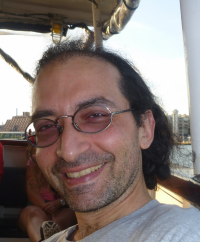Dionisios Margetis, Prof. at the University of Maryland, Inst. for Phys. Sci. and Tech., and Dept. of Mathematics, to speak at ECE NTUA on January 11, 2019 at 14:00

Lecture Title: Plasmonics on 2D materials: A flavor of dispersion and homogenization.
Abstract:
In the last decade, tremendous advances have been made in the fabrication of two-dimensional (2D) materials with novel electronic structure. Celebrated examples are graphene and black phosphorus. The surface conductivity of these systems in the infrared regime may permit the generation of fine-scale electromagnetic waves, surface plasmon-polaritons (SPPs), on the 2D material.
In this talk, I discuss two theoretical problems related to SPPs via solutions of time-harmonic Maxwell's equations. In particular, I focus on:
(i) The dispersion of SPPs along edges of anisotropic 2D materials by use of the Wiener-Hopf technique.
(ii) The homogenization of layered, periodic structures of 2D materials: By use of an asymptotic analysis and finite element numerical simulations, we derive and study a system of effective Maxwell's equations. An appealing, emergent property in (ii) is the possible propagation of macroscopic waves with almost no phase delay (epsilon-near-zero effect).
The talk is based on joint work with E. Kaxiras (Physics, Harvard), M. Luskin (Math, U. Minnesota), M. Maier (Math, U. Texas A&M), and M. Mattheakis (Physics, Harvard).
Biographical Sketch:
Dionisios Margetis is a Professor at the University of Maryland. After receiving an EE Diploma from NTUA, he went on to Harvard for a PhD in Applied Physics. Then, he carried out postdoctoral work at Harvard and M.I.T.. He joined the faculty at the University of Maryland in 2006. He has been a full Professor of Mathematics since 2012. He was a recipient of: a National Science Foundation Career Award; two Research and Scholarship Awards, and Dean's Award for Excellence in Teaching at Maryland; and Dean's Prize for Excellence in Graduate Education by M.I.T. His current research focuses on epitaxial growth, plasmonics and quantum dynamics.
